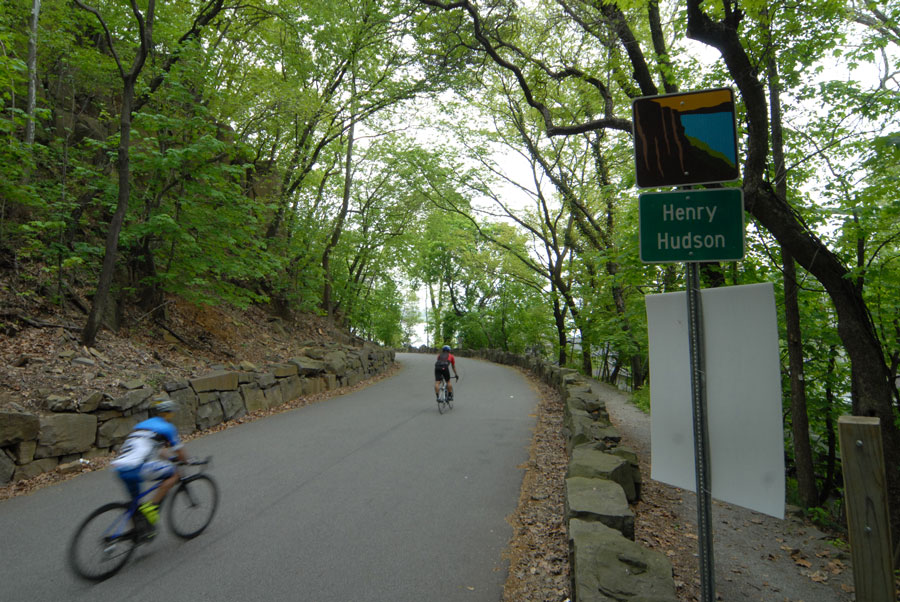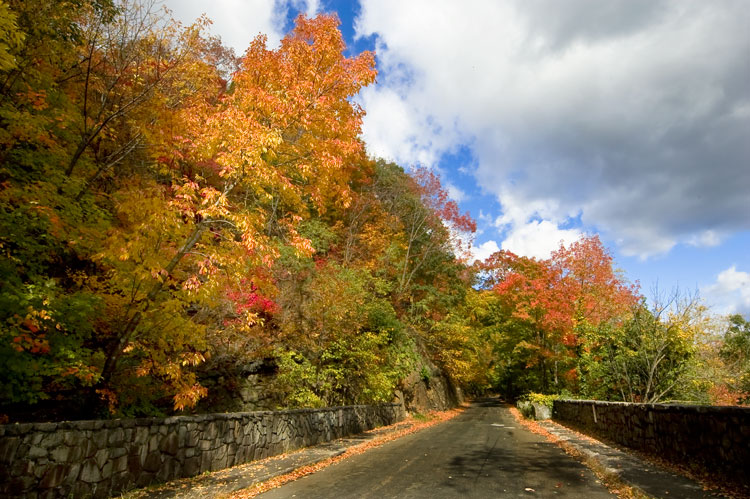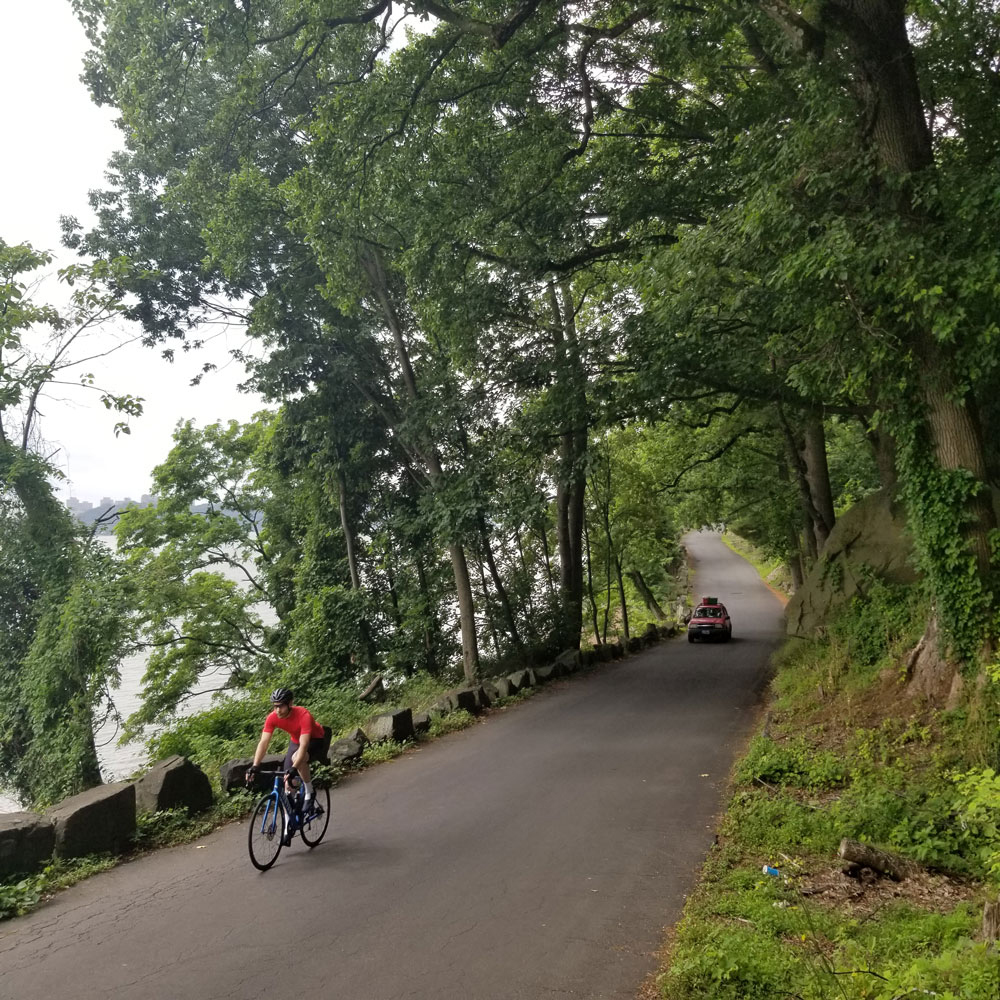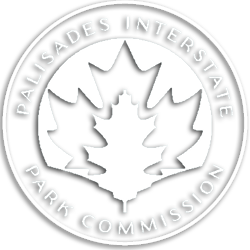On the Drive
A “Cliff Notes” Story
April 2017
A bike ride on Henry Hudson Drive — the eight-mile roadway through the southern half of this park — is more than just good exercise. It puts you in touch with the story of the Palisades.

Heading north from the Edgewater park entrance, the first mile of the Drive curves beneath the Fort Lee bluff — where the Continental Army placed its batteries in the fall of 1776 — then ducks behind the legs of the George Washington Bridge, straddling the river there like a giant steel brontosaur, its belly rumbling full of traffic. The Drive keeps a slow grade down and down—and into the forgotten heart of the enormous Carpenter Brothers’ quarry.
A wide circle in the Drive, providing access to Ross Dock Picnic Area below, marks where, in the 1890s, a crew of three hundred men labored with muscle and dynamite, week in and week out, to pull down the mountainside. Stop a moment and consider: the sunlit space of this circle was once embedded within an unimaginable weight of cold stone. Here, and at similar quarries up the river, toppled columns of the Palisades were crushed into gravel-sized pieces. Big conveyer belts loaded the crushed stone onto barges, to be shipped as far away as New Orleans. But by 1900, public protest, led by New Jersey’s Women’s Clubs, pushed the governments of New York and New Jersey to come together, to form a unique Interstate Commission, and to stand against the “vandals” at the quarries. By Christmastime that same year, the new Commission was able to halt the quarrying here — and to begin to turn the battered riverfront into a public park.

Two miles in, and you finally get to the base of that first long hill—and the edge of the Hudson. Now it’s 1912: the year the Interstate Commission first proposed a road from the “top of the Cliffs at the head of Palisades Avenue at Englewood, running down the face of the Palisades” to Englewood Landing — here — to connect with a ferry that would cross the river from the base of Dyckman Street in Manhattan. Known as Dyckman Hill Road, this steep and winding section of the Drive (bicycles must be walked on the upper portions) follows a carriage road, which had in turn been built around 1870 for the Palisades Mountain House, a grand hotel on the summit (the Mountain House burned down in 1884). Workers spent two years widening and improving the old road, cutting into the cliff face, building the tall gray stone walls alongside the roadway. They even installed streetlamps, so the new ferry service could run late into the night. By 1930, over a million vehicles crossed on this ferry each year — along with many more pedestrians, most of them departing the city to come to the new park, with its bustling picnic areas, campgrounds, and riverfront bathing beaches.

For the next mile, as they extended the Drive north from Dyckman Hill, the workers were able to make use of another old carriage road, “Undercliff Avenue.” At the junction they’d hang a big wooden sign that warned you were about to enter a “narrow winding motor trail.” For some years, an old one-room schoolhouse stood just beyond the junction, and the noted painter Van Deering Perrine rented it from the Commission for his winter studio. (Perrine had urged the president of the Commission not to build the new road, fearing it would spoil the wildness of the Palisades he loved so.) The “Undercliff” section dipped back down to river level, where a handful of houses still stood at the old docks, home to the last residents of what had been known as “Fishermen’s Village.” This became the site of the park’s Undercliff Picnic Area and Bathing Beach (a big stone bathhouse was built there in 1922 — cyclists glimpse the ruins as they glide above on the Drive). At the end of “Undercliff Avenue,” as winter brought construction to a halt, the workers built a turn-around. (This wide spot in the Drive was later used as a parking space for a beach area below it: “Canoe Beach Circle” still exists, the “circle to nowhere” at about the midpoint of the Drive.) The next year, 1916, they had to break new ground, climbing back up the talus slope — until they met their biggest challenge yet.
The Commission’s chief engineer was A. K. Morgan, and it was he who designed the single-span concrete bridge that crosses 250 dizzy feet above the base of Greenbrook Falls. Finished a century ago, it forms the apex of the main part of the Drive.

About a mile past Greenbrook Falls you fall back in time again — all the way to the Revolution: on November 20, 1776, a British Army of five thousand men, under the command of General Charles Cornwallis, crossed the Hudson from New York to land at the “New Dock” — later called “Huyler’s Landing.” They climbed a farm road — now a hiking trail that crosses Henry Hudson Drive here — to attack Fort Lee. (The Americans at Fort Lee were just able to escape capture, in what became known to history as their “Retreat to Victory”…)
Another mile, another circle: right goes down to Alpine Landing; left goes up one final mile to the summit. This part of the Drive, “Alpine Approach Road,” opened in 1923 for a ferry service from Yonkers. (Never as busy as the Dyckman ferry, the Yonkers ferry nevertheless carried up to half a million vehicles a year during the height of its operation.)

A century of steady use — by cyclists and pedestrians, as well as the “motorists” for whom it was designed — not to mention the endless pummeling of rock slides — and the Drive remains a favorite feature in the park: a secret treasure of Bergen County, hidden in plain sight of the great metropolis across the river.

– Eric Nelsen –

